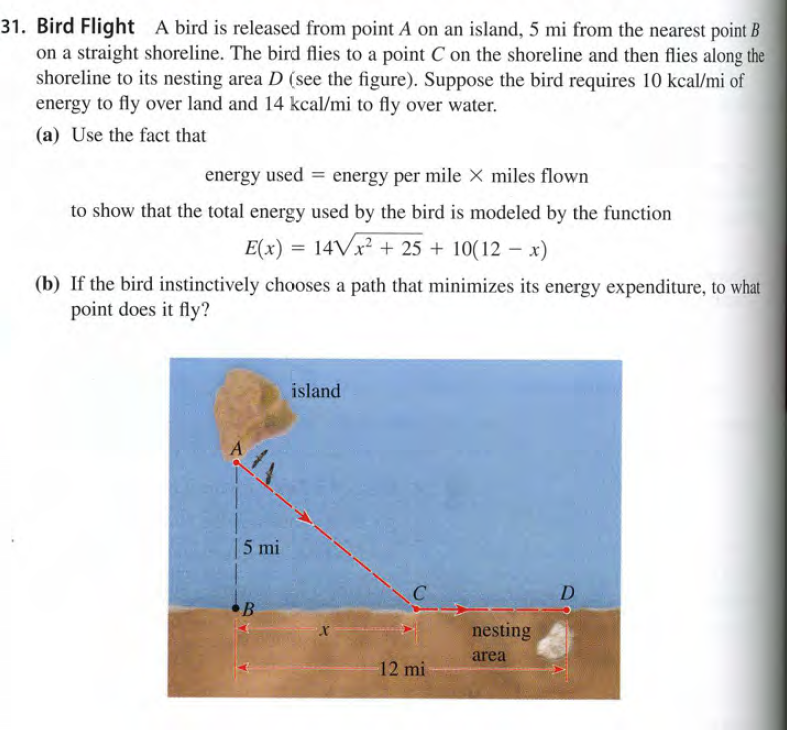31. Bird Flight A bird is released from point A on an island, 5 mi from the nearest point B on a straight shoreline. The bird flies to a point C on the shoreline and then flies along the shoreline to its nesting area D (see the figure). Suppose the bird requires 10 kcal/mi of energy to fly over land and 14 kcal/mi to fly over water. (a) Use the fact that energy used = energy per mile X miles flown to show that the total energy used by the bird is modeled by the function E(x) = 14VX² + 25 + 10(12 – x) (b) If the bird instinctively chooses a path that minimizes its energy expenditure, to what point does it fly? island [5 mi D nesting area 12 mi
31. Bird Flight A bird is released from point A on an island, 5 mi from the nearest point B on a straight shoreline. The bird flies to a point C on the shoreline and then flies along the shoreline to its nesting area D (see the figure). Suppose the bird requires 10 kcal/mi of energy to fly over land and 14 kcal/mi to fly over water. (a) Use the fact that energy used = energy per mile X miles flown to show that the total energy used by the bird is modeled by the function E(x) = 14VX² + 25 + 10(12 – x) (b) If the bird instinctively chooses a path that minimizes its energy expenditure, to what point does it fly? island [5 mi D nesting area 12 mi
Algebra & Trigonometry with Analytic Geometry
13th Edition
ISBN:9781133382119
Author:Swokowski
Publisher:Swokowski
Chapter5: Inverse, Exponential, And Logarithmic Functions
Section5.6: Exponential And Logarithmic Equations
Problem 51E
Related questions
Question
In the problem you are asked to find a

Transcribed Image Text:31. Bird Flight A bird is released from point A on an island, 5 mi from the nearest point B
on a straight shoreline. The bird flies to a point C on the shoreline and then flies along the
shoreline to its nesting area D (see the figure). Suppose the bird requires 10 kcal/mi of
energy to fly over land and 14 kcal/mi to fly over water.
(a) Use the fact that
energy used = energy per mile X miles flown
to show that the total energy used by the bird is modeled by the function
E(x) = 14VX² + 25 + 10(12 – x)
(b) If the bird instinctively chooses a path that minimizes its energy expenditure, to what
point does it fly?
island
[5 mi
D
nesting
area
12 mi
Expert Solution
This question has been solved!
Explore an expertly crafted, step-by-step solution for a thorough understanding of key concepts.
This is a popular solution!
Trending now
This is a popular solution!
Step by step
Solved in 3 steps

Knowledge Booster
Learn more about
Need a deep-dive on the concept behind this application? Look no further. Learn more about this topic, geometry and related others by exploring similar questions and additional content below.Recommended textbooks for you

Algebra & Trigonometry with Analytic Geometry
Algebra
ISBN:
9781133382119
Author:
Swokowski
Publisher:
Cengage

Algebra & Trigonometry with Analytic Geometry
Algebra
ISBN:
9781133382119
Author:
Swokowski
Publisher:
Cengage